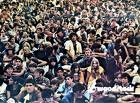
Clay Shirky’s comparison of Gin and Television as mechanisms by which pain is soothed, and a cognitive surplus created, connects with a number of things I’ve been thinking of recently. The appropriate response to Shirky’s essay is to create another essay, or perhaps a photograph, that comments and connects to it. We live in a consumer society, and thanks to folks like Ralph Nader, we have some rights as consumers. But we are coming to the end of the era where we define ourselves by what we consume.
With the vast new set of consumption choices flowing through the network, the issue of gluttony arises. You can’t just eat everything. Human beings don’t scale, and human attention doesn’t obey Moore’s law. What happens when our total number of waking hours, and not just for today, but for the rest of our lives, can be filled with high quality “content” programmed by the best curators and editors on the planet? Fill out a profile, push a button, and the entire sequence can be put into a feed ready for your attention. As material is consumed, and new material becomes available, a constant recalculation of your feed will occur assuring that you will always have the highest quality and most appropriate “content” available. Philip K. Dick is smiling somewhere.
The assumption built into this model is that we just need more and better gin. Shirky points out that if we went on the wagon, we’d have a tremendous surplus of time on our hands. And if we look at what the digital natives are doing, we’d see that 100% consumption is boring. They want all transaction to be full duplex, read/write, consume/produce. At its origin, Tim Berners-Lee created a 2-way web, but the conversation shouldn’t be limited to the network.
If we become a nation of producers as well as consumers, won’t there even be more content to consume? Yes, but there will be no obligation to consume it all. It’s also important to remember that all conversations don’t happen with words (written or spoken). A photograph can speak to an essay, so can a melody, a video, a dance, a scribble in a notebook or a painting. With a whole new set of tools and media widely available, I see a nation returning en mass to their parlor pianos and singing a song about “gin and television” and then uploading a video of it to YouTube.
Comments closed
